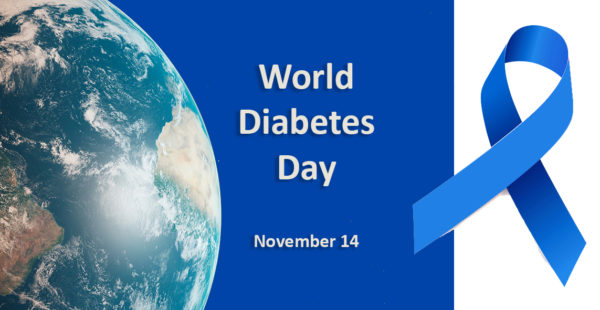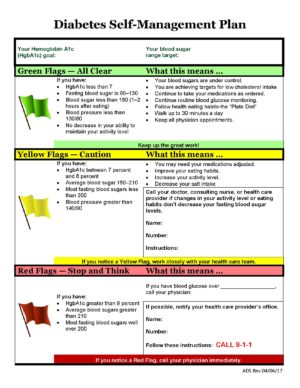Diabetes: Education to Protect Tomorrow

November 14 is World Diabetes Day. It was created in 1991 by the International Diabetes Foundation and the World Health Organization, falling on the birthday of Sir Frederick Banting, who co-discovered insulin along with Charles Best in 1922.
The World Diabetes Federation developed a theme to mark this occasion in 2022: Education to Protect Tomorrow. It focuses on access to diabetes education, which includes people gaining knowledge, skills, and abilities to manage their diabetes.
Many believe you must have a confirmed diagnosis of diabetes to be concerned; however, prediabetes is a serious health condition where your blood sugars are higher than normal but not yet high enough to be diagnosed as a Type 2 (sometimes referred adult-onset) diabetes.

Caption: Click on the link above to open and then download the Diabetes Self-Management Plan in English. Translations are also available in Russian, Spanish, Tagalog, Simplified Chinese, Traditional Chinese, and Vietnamese.
According to the Centers for Disease Control, more than one in three adults in the United States has prediabetes—88 million people—but most people don’t know they have it!
Worldwide, diabetes currently affects one in ten people. Three in four adults with diabetes live in low- and middle-income countries.
We know that you cannot address what you don’t know. Obtaining an understanding of a condition is the first step towards managing and preventing it, especially for diabetes. The problem is, however, is that diabetes education is complex and accessing the information can be challenging. Factors including access to healthcare, a healthcare provider, impacts of lower literacy and health literacy levels, language, cultural, social, and financial barriers. It is important that these obstacles are recognized and addressed if we—as a community and society—want to address diabetes prevention and treatment.
Here are some things I want you to know:
- Diabetes is a chronic or persistent health condition that affects how a body turns food into energy. The pancreas does not produce enough insulin, or the body cannot effectively use the insulin in produces. This leads to an increased concentration of glucose in the blood. That’s called hyperglycemia.
- Type 1 diabetes (previously known as insulin-dependent or childhood-onset diabetes) is characterized by a lack of insulin production.
- Type 2 diabetes (formerly called non-insulin-dependent or adult-onset diabetes) is caused by the body’s ineffective use of insulin. It often results from excess body weight and physical inactivity.
- Diabetes impacts your entire body, including your brain, heart, skin, feet, eyes, ears, oral health, kidneys, and other body systems.
- Everyone is unique, so medication(s), treatment(s) or an eating plan that might work for one person may not work for someone else.
Here are some of the risk factors:
- Family history of diabetes
- Obesity
- Lack of regular physical activity
- Race—African Americans, Latinx, Indigenous, and Alaska Native people are at highest risk. Some Pacific Islanders and Asian Americans are also at higher risk.
- Social determinants of health—consider that, without safe and stable housing, the financial ability to access and pay for care, transportation to get to appointments, etc., we will not be successful in living and thriving with diabetes.
Talk with your health care provider about self-management of diabetes:
- Print our Diabetes Self-Management Plan (at right) and take it with you to your appointment.
- Learn the signs and symptoms of high and low blood sugar.
- Know what to report to a health care provider when your diabetes is not well controlled.
- If regular glucose testing is required and/or medications are prescribed, ask for help to make sure you know how to test and how to take oral or injectable medications.
Consider lifestyle and daily habit changes:
- Though it can be hard, remember, you do not need to change everything at once. Start with one decision towards diabetes management. You might have challenges or setbacks—these are normal. Do not think about it as failure, but as a “bump” in the road, and get back on track as soon as possible.
- Move more! Limit the amount of time you sit. Get up frequently and try to get at least 30 minutes of physical activity, five days a week. You can break the time into three 10-minute sessions if that works best for you. If you do sit, consider chair exercises, leg lifts, arm raises, and other stretches.
- Choose healthier foods and drinks. Consider eating foods that are high in fiber and low in fat and sugar. Using the MyPlate method, build a plate that includes a balanced portion of vegetables, protein, and carbohydrates. Consider drinking water instead of sweetened drinks.
- If you are overweight, consider taking steps to lose weight and keep the weight off once we lose it. You might be able to prevent or delay diabetes by losing just five percent to seven percent of your current weight. For example, if a person weighs 180 pounds, a seven percent weight loss would be 12.6 pounds.
Get support!
- It is possible to reverse prediabetes. Once you have type 2 diabetes, you have a chronic condition. Diabetes management can be challenging, but not impossible if you have the support and encouragement of family, friends, and your healthcare team.
- Make sure you stay up to date on your vaccinations! Talk with your healthcare provider about COVID-19 booster vaccine and the flu vaccine. People with diabetes—especially if it is not well controlled—are more likely to get sick from COVID-19 and/or the flu.
- Consider taking a diabetes self-management class. Learn more here.
As the saying goes, knowledge is power. Together, we as a community collaborative can work to provide diabetes education that can make a difference in the lives of those living with diabetes.
 Contributor Mary Pat O’Leary, RN, BSN is a senior planner at Aging and Disability Services, Seattle Human Services Department.
Contributor Mary Pat O’Leary, RN, BSN is a senior planner at Aging and Disability Services, Seattle Human Services Department.
![AgeWise King County [logo]](https://www.agewisekingcounty.org/wp-content/themes/agewisekingcounty/images/logo.png)